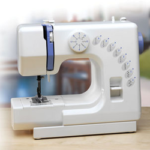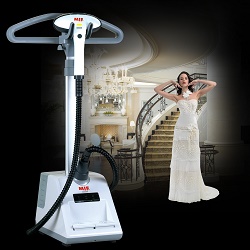How to choose the right thread for a sewing machine
The formation of the perfect stitch on the product depends on many factors, including the correct selection of threads. If their thickness does not match with the type of fabric or needle size can be observed unevenness or lack of stitches. Regular breaking of a thread can cause suspicion about malfunction of equipment. These factors, of course, can cause incorrect equipment setup, but in more frequent cases the reason is the wrong choice of thread. About what threads are needed for high-quality work of sewing machines, and will be discussed below.
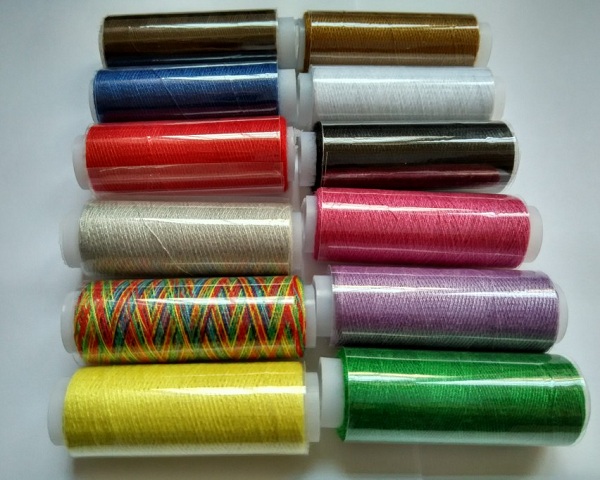
Content
Varieties of threads and their use for sewing equipment
The instructions for the sewing machine have recommendations from the manufacturer regarding the setting of sewing modes independing on the type of material. There is also information on the use of thread and needle compliance. Let us consider in more detail the existing types of threads for sewing and their features.
Cotton
The best solution for sewing and repairing clothes with the help of a sewing machine in combination with manual work will be ordinary cotton threads. They are the most popular and common for both amateurs and professionals. HB threads are the most affordable and cheap, besides they are suitable for almost any type of fabric. Universal size such thread number 50, but if the fabric is too thin, it may tear it or leave holes on the stitches, and when sewing coarse clothing, strength may not be enough, and the seam will disperse. Therefore, it is necessary to select the desired thickness or use other types of thread.
Polyester
Synthetic threads allow you to make the most beautiful line. The fiber structure is smooth, the thread does not shake in stitches, therefore it is often used in finishing linewhen it should be perfect. In addition, they are very durable and do not tear at a slight stretch. Coils are labeled - 100% polyester.In Russian stores are more common trademarks "Nitex" and "Ideal".
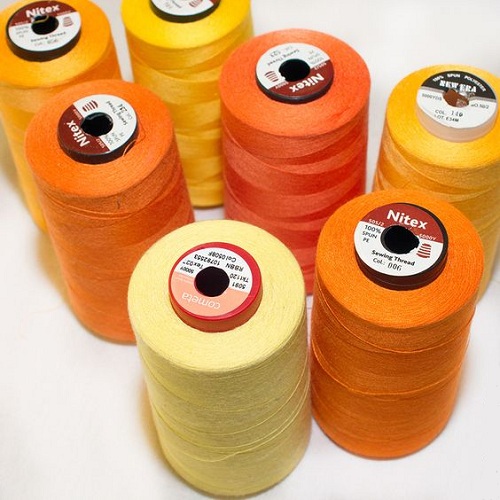
Polyester sewing thread brand "Nitex"
Reinforced
They differ wear resistance and elasticity due to the peculiarities of the structure of the fiber, in which the lavsan base is braided by various fibers. Russian marking of the coil, depending on the type of material, may be the following symbols: LH - cotton thread, LL - flax, LS — wool. Also there are digital designations of thickness: the higher the number, the thinner the thread.
Nylon
These threads are moisture resistant and tough enough, so fit for shoes, bags. In the elements of clothing used for a hidden line or bending of the product. It is of two types: monofilament and twisted of several fibers.
Silk
Silk thread is used not only for silk and wool fabrics, it is perfect for many types of material. Color resistant, does not fade when ironing or washing at high temperatures. The main thing is to choose the right size in accordance with the fibrous structure of the fabric.
There are also special threads for decorative patterns on clothes.Metallized threads can also be used to decorate or create an exclusive product.

Silk Sewing Threads
Selection of threads depending on the texture of the material used
When sewing, very often not only colors of fabrics are combined, but also a different type is used. fiber composition. Depending on this, strings of different thickness are used for sewing machines.
- For sewing children's clothes, cotton and knitwear suitable conventional cotton thread of good quality. The most optimal size is number 40.
- For lightweight things made of chiffon, as well as tulle, a reel with size No. 70-80 is suitable.
- For thick suiting fabric can be used thread No. 50-70.
- Thin wool products, satin and synthetic materials look good with stitches with a thickness of from 40 to 70.
- Heavy fabrics, natural and artificial leather fit denser thread No. 30-40.
Silk thread is universal and can be used for almost all types of fabrics. For thinner material thread 120/3 is suitable. Further, it is directly proportional to a decrease in the size of the thread with an increase in the thickness of the fabric:
- Crepe de Chine; Batista - No. 100/3;
- calico, raincoat, thick silk - №60 / 3;
- drape, burlap, tarpaulin number 40/3.
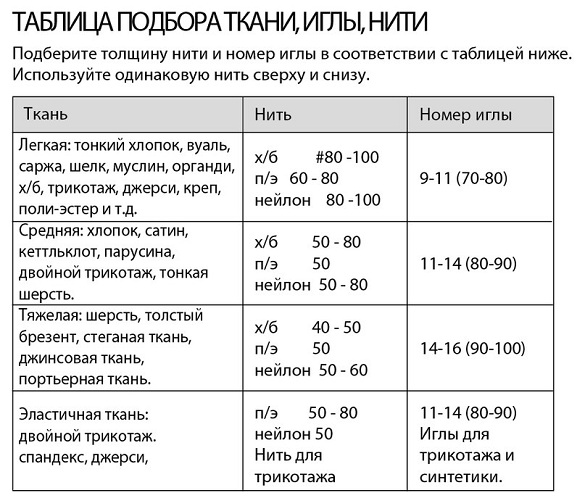
For fastening of several elements very convenient colorless nylon thread. In this case, its size is selected on the basis of the basic type of fabric of the product.
Tips for quality sewing
Inventing a new masterpiece in the field of fashion, work on a sewing machine is accompanied by hand-sewing. Decor, basting and much more are done manually. To save time, you can choose the optimal type of thread, which is most suitable at all stages of production of the product with the help of a sewing machine. Here are some tips for newbies that will make the sewing process easier and more comfortable.
- If the thread is selected in accordance with the fabric, there should be no error in the stitch. If the stitching tightens the fabric or loops remain, you need to adjust the tension of the upper and lower threads on the machine.
- For outsole it is better to use a silk thread, as it does not leave a mark when ironed, does not get confused and is easily removed.
- When sewing silk products in the color range, there can be a strong tone break, this will be almost negligible on the product.
- The thickness of the upper and lower threads should be the same and correspond to the texture of the fabric.
It is important to remember that the quality of the stitching directly depends on the quality of the threads, their conformity with the material used for sewing. Also stitch perfection can affect needle size. The last stage of preparation is setting up sewing equipment, adjusting the thread tension. To make sure that the settings are correct, before starting to scribble, it is better to check the type of stitch on the fabric flap of the future product. So do many, even professional masters.

/rating_off.png)






